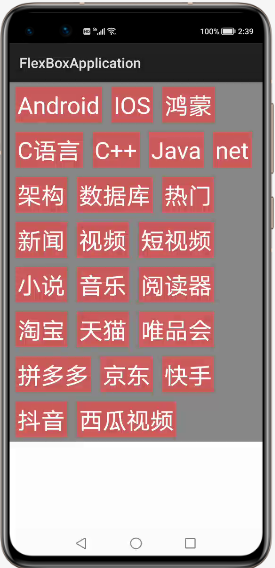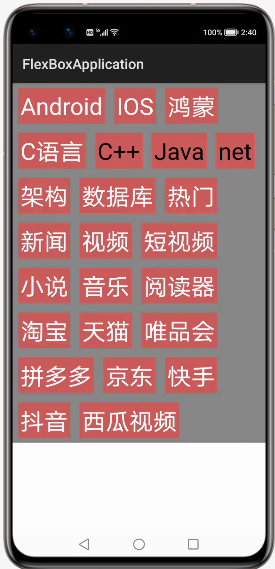目录:
引言
上一篇给大家介绍底部导航栏的组件使用及开发指南,本篇将给大家带来另一个鸿蒙三方件的是实现:Flexbox,何为Flexbox,如果对Java的Swing比较熟悉的话一定不会陌生,就是控件根据ViewGroup的宽,自动的往右添加,如果当前行剩余空间不足,则自动添加到下一行。有点所有的控件都往左飘的感觉,第一行满了,往第二行飘~所以也叫流式布局。鸿蒙并没有提供流式布局,但是某些场合中,流式布局还是非常适合使用的,比如关键字标签,搜索热词列表等,比如下图:


这些都特别适合使用Flexbox,本篇会带领大家自己实现Flexbox,然后使用我们自己定义的Flexbox实现上面的标签效果。学会使用一个控件和学会写一个控件,我相信大家都明白,授人以鱼不如授人以渔。
接下来看下鸿蒙模拟器的实现效果,效果图如下:
图(1)默认标签状态

图(2)标签选中状态

VideoCache使用指南
Ø 新建工程, 添加组件Har包依赖
在应用模块中添加HAR,只需要将flexboxlibrary-debug.har复制到entrylibs目录下即可
Ø 修改配置文件
1. 在布局中添加如下代码:
2.在代码中通过以下方式使用:
VideoCache开发指南
在上述中,已经说明Flexbox 如何在开发过程中使用,接下来简单的分析下Flexbox 实现思路
1、对于Flexbox ,需要指定的LayoutConfig,我们目前只需要能够识别margin、padding即可
2、measureChild中计算所有childView的宽度,然后根据childView的宽度,计算当前每一行的宽度
3、最后根据计算之后的宽度,对中所有的childView进行布局。
以text为例,计算每个childView 的代码如下:
初始化每行的布局,代码如下:
获取屏幕的宽度,代码如下:
动态布局:
定义接口,实现item的点击事件
按照思路看下来,是不是很简单呢?我们只需要把握住如何计算childview 的宽度,以及什么情况下添加新的一行即可。
更多原创,请关注:https://harmonyos.51cto.com/column/30
作者:软通田可辉
想了解更多内容,请访问51CTO和华为合作共建的鸿蒙社区:https://harmonyos.51cto.com